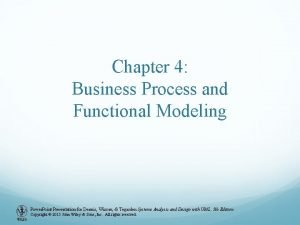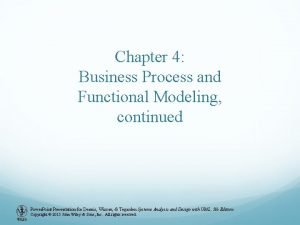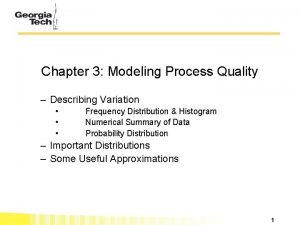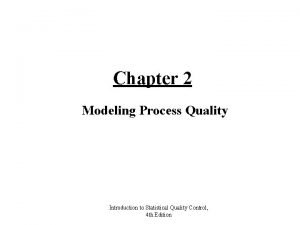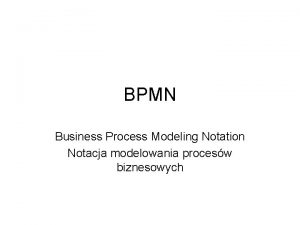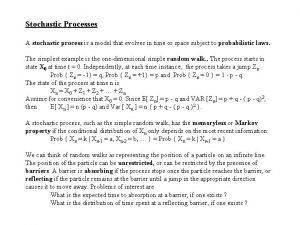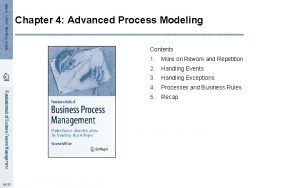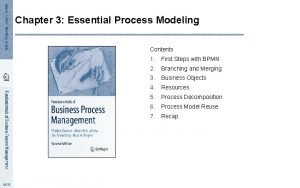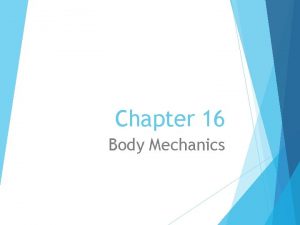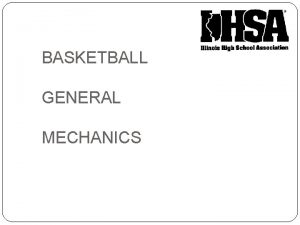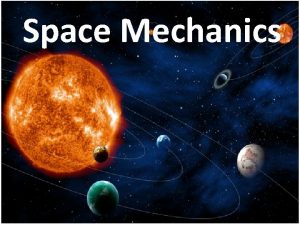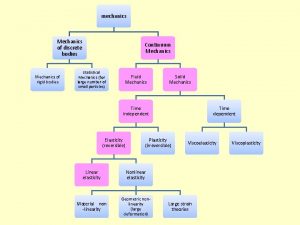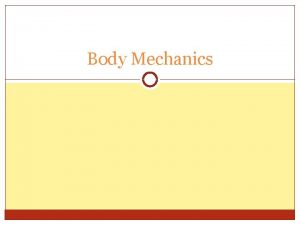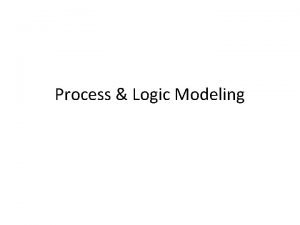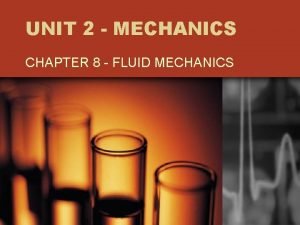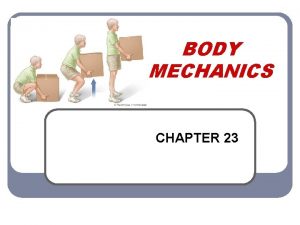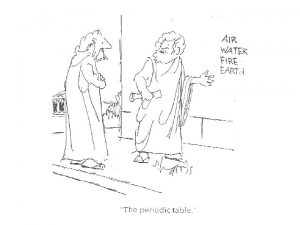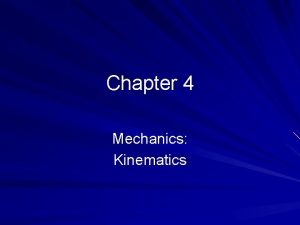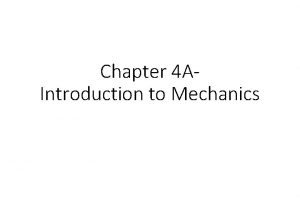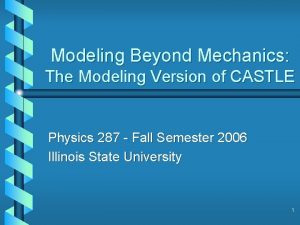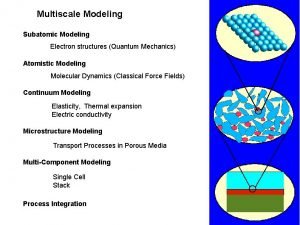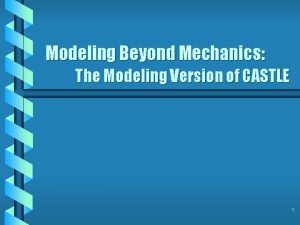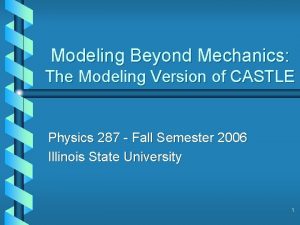Chapter 7 Process Modeling Agenda Process modeling mechanics






















- Slides: 22

Chapter 7 Process Modeling

Agenda Process modeling mechanics l Some rules for building DFDs l Decomposing DFDs l Using DFDs for better analysis l Examples l

Learning Objectives l After this chapter, you should be able to: – Read and interpret process models (DFDs) – Construct DFDs using specific rules and guidelines presented in the chapter – Decompose DFDs into lower-level diagrams – Balance higher- and lower-level DFDs – Explain differences among 4 types of DFDs – Use data flow diagrams as a tool to support the analysis process – Explain and diagram use cases to model system

Processing Modeling Part of Requirements Structuring within the Analysis Phase of the SDLC l A common form of process modeling is the data flow diagram (DFD) l DFD is a picture of the movement between external entities and the processes and data stores within a system. l

Deliverables for Process Modeling Context diagram l DFDs of current physical system (as needed) l DFDs of current logical system l DFDs of new logical system l Descriptions of each DFD component l

DFD Definitions l Data Store l Process l Source/sink l Data flow Think about: How are these concepts related to general principles of “systems thinking” from Appendix 1?

Example l Fast Food Restaurant – Think of Events and Describe – Sources/Sinks » What data are provided by what external components » What data are received by what external components – Processes » What components transform data » What are those transformations – Data Flows » For a specific interrelationship of components, what specific data (attributes of entities) flow » What is the interface that facilitates that flow – Data stores » What are some data stores, i. e. , components that hold data » For one, what specific data (attributes of entities) are stored

Symbols Process Data store Source/ Sink Data flow

Diagrams l Context: Overview of an organizational system that shows boundaries, external entities, and major information flows – See Figure 7 -4 (p. 203) l Level-0: Represents a system’s major processes, data flows, and data stores at a high level of detail – See Figure 7 -5 (p. 204)

Some—But Not All—Basic DFD Rules (Know Table 7 -2 and Figure 7 -6!) l l l l Inputs of a process are different than the outputs—the process makes some change to the data, or else it must not be needed! Objects on a DFD have unique names Processes must have both inputs and outputs, otherwise they are a source or a sink Process = verb—it DOES something Data can’t go directly from a store to another store—must be moved via process Data store = noun Data can’t go directly from a source to a sink—must move via process

Rules, and More Rules (cont. ) l l l Data flows in one direction at a time (no two-headed arrows) Data flow can’t go directly back to the same process it leaves—must go via at least one other process (otherwise, why did it have to leave in the first place? ) Data flow to a data store means update (delete or change) Data flow from a data store means retrieve or use Data flow has a noun phrase label (type of data moving)

Decomposition l What is functional decomposition? l Why is it important? l How does this apply to DFDs?

More Decomposition When the system is broken down to its lowest level, this is known as the primitive level l Level n-diagram: Is a DFD that is generated from n nested decompositions from a level 0 diagram l

Balancing DFDs l l Conservation of inputs and outputs when the process is decomposed to a lower level DFDs must have the “same” inputs and outputs when decomposing—decomposing simply adds detail internal to the system – Compare Figure 7 -4 and 7 -5 (pp. 203 -204) – Compare Figure 7 -5 and 7 -8 (pp. 204, 209)

DFD Types l Current Physical l Current Logical l New Physical

Guidelines for DFD Complete l Consistent l Timing issues l Iterative nature l Primitive DFD l – How to know when you’re there?

Developing DFDs: Develop context and Level-0 DFDs for the Open Road Insurance system The purpose of the Open Road Insurance system is to provide automotive insurance to car owners. Initially, customers are required to fill out an insurance application request. A driver’s record request is sent to the local police department, which sends back a driver’s record report. Also, a vehicle registration request is sent to the Department of Motor Vehicles, which supplies a vehicle registration. Policy contracts are sent in by various insurance companies. The agent determines the best policy for the type and level of coverage desired and gives the customer a copy of the insurance policy along with an insurance coverage card. The customer information is now stored. Periodically, a fee statement is generated, which – along with addendums to the policy – is sent to the customer, who responds by sending in a payment with the fee stub.

Developing DFDs: Develop context and Level-0 DFDs for a dentist office system; Is description complete? Whenever new patients are seen for the first time, they complete a patient information form that asks for their name, address, phone number, and brief medical history, which are stored in the patient information file. When a patient calls to schedule a new appointment or change an existing appointment, the receptionist checks the appointment file for an available time. Once a good time is found for the patient, the appointment is scheduled. If the patient is a new patient, an incomplete entry is made in the patient file; the full information will be collected when the patient arrives for the appointment. Because appointments are often made so far in advance, the receptionist usually mails a reminder postcard to each patient 2 weeks before his or her appointment.

Developing DFDs: Develop context and Level-0 DFDs for a real estate system; Is description complete; is Level-0 primitive? A Real Estate Inc. (AREI) sells houses. People who want to sell their houses sign a contract with AREI and provide information on their house. This information is kept in a database by AREI and a subset of this information is sent to the citywide multiple-listing service used by all real estate agents. AREI works with two types of potential buyers. Some buyers have an interest in one specific house. In this case, AREI prints information from its database, which the real estate agent uses to help show the house to the buyer (a process beyond the scope of the system to be modeled). Other buyers seek AREI’s adivce in finding a house that meets their needs. In this case, the buyer completes a buyer information form that is entered into a buyer database, and the AREI real estate agents use its information to search AREI’s database and the multiple-listing service for houses that meet their needs. The results of these searches are printed and used to help the real estate agent show houses to the buyer.

Summary What is a DFD? l Why use a DFD? l What is a context diagram? l What are different levels of DFDs? l What are balanced DFDs? l What are different types of DFDs? l Learn the rules for constructing DFDs. l

Context Diagram (Figure 7 -4) Return

Level 0 Diagram (Figure 7 -5) Return
 Agenda sistemica y agenda institucional
Agenda sistemica y agenda institucional Modeling role modeling theory
Modeling role modeling theory Dimensional modeling vs relational modeling
Dimensional modeling vs relational modeling Rapid process improvement workshop
Rapid process improvement workshop Process modeling in system analysis and design
Process modeling in system analysis and design Business process and functional modeling
Business process and functional modeling Business process and functional modeling
Business process and functional modeling Modeling process quality
Modeling process quality Modeling process quality
Modeling process quality Four-model approach
Four-model approach Uml xor
Uml xor Stochastic process modeling
Stochastic process modeling Function allocation diagram aris
Function allocation diagram aris Advanced process modelling
Advanced process modelling Bpmn data store example
Bpmn data store example Dfd chapter 5
Dfd chapter 5 Chapter 6 safety and body mechanics
Chapter 6 safety and body mechanics Fluid kinematics is part of fluid mechanics in which
Fluid kinematics is part of fluid mechanics in which Mechanics of materials 6th edition solutions chapter 10
Mechanics of materials 6th edition solutions chapter 10 Mechanics of materials chapter 9
Mechanics of materials chapter 9 Mechanics of materials 7th edition solutions chapter 7
Mechanics of materials 7th edition solutions chapter 7 Mechanic of materials
Mechanic of materials Beer johnston
Beer johnston





